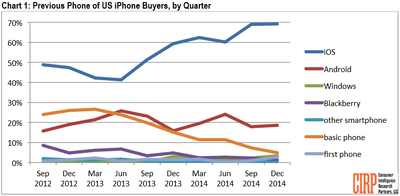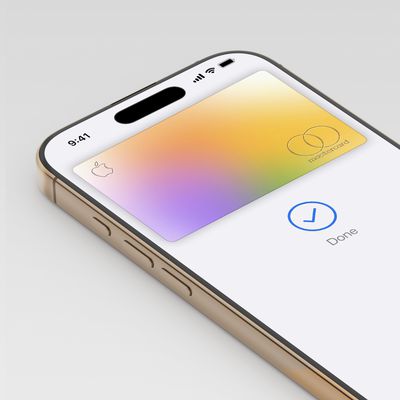Following Apple's earnings call on Tuesday in which Tim Cook stated the company "saw more new customers to iPhone than we've ever seen before," research firm Consumer Intelligence Research Partners (CIRP) today released (via Fortune) a report delving into the specifics of the Android-to-Apple switching statistics revealed by Apple.
Expectedly, the report - which surveyed 500 Apple device customers inside the U.S. only - notes most Apple iPhone users returned to the company with the newest iteration of the iPhone last year. But the rate of Android switchers migrating platforms to the iPhone 6 or 6 Plus wasn't much changed.

CIRP notes that the rate of Android switchers has "varied seasonally, yet remained relatively consistent," and this quarter's U.S. numbers have the firm speculating the biggest rate of Android-to-Apple switching occurred outside of the U.S.
“Apple CEO Tim Cook indicated the iPhone 6 and 6 Plus 'experienced the highest Android switcher rate in any of the last three launches.' The US switch rate for the iPhone 6 and 6 Plus launch did increase relative to the iPhone 5S/5C launch a year ago, and was about the same as the iPhone 5 launch in 2012. This week, Apple emphasized the international strength of the iPhone 6 and 6 Plus launch, so it appears that Apple enjoyed a much higher rate of Android switching outside the US than in the more mature US market," said Mike Levin, Partner and Co-Founder of CIRP.”
Given Apple's strong position in the smartphone market in the U.S., where there is a strong base of iPhone-to-iPhone upgrades and fewer from Android-to-iPhone, CIRP's report probably isn't too far off from fact. Apple's smaller presence in emerging markets like China, where it has been seeing very strong growth thanks to a few notable partnerships and store openings in the country has likely fueled some overseas brand switching among previously loyal Android users.
























Top Rated Comments
Though an iphone is easier to pick up and learn I found pure android more a more efficient operating system to use with more customization. Still better with notifications, I like being able to place icons where I want and not have to have them auto arrange top to bottom of a page. Bottom back arrow key makes navigating easier. Clock weather widgets are nice to have on the springboard, hiding icons you don't use very often in an app drawer is cleaner, you can customize the look with launchers, it's more open.
I find as apple has added features they have done it a little less efficiently.
Unless ios or the next iphone model has something super amazing I'll probably go back to android when I'm due for my next upgrade.
It is a survey, not a cenuses. Suveys can be accurate even if the sample size seems small to you, if you do it properly. Statistics are a valid form of evidence in many courts in the world.
Mac OS has had the ability to keep things sorted by name since the mid 80s. You'd think iOS in 2015 can have a "view options" for folders. The UI is so wasteful of space as it is, there is plenty of room for a gear or 3 horz lines icon to tap to set view options in folders and on home screens.
That's what I do. Again the drawer is just cleaner and you can sort the drawer which I kept alphabetical which made it easy to find an app I rarely used. iOs still needs a huge overhaul in my opinion. iOs 7 was really mostly a theme update like a winterboard theme and ios 8 some added some catch up features.
I guess I'll give ios some props for iMessage. It's features make it my favourite messaging app other than it would be nice if it was on multi platforms since I can't force people to own iphones. I also like the fairly simple and quick photo taking camera.
Or... North Americans are realizing that there are other quality phones besides the iPhone and opting not to switch.
Agree with most points. Apple is locked into a paradigm that isn't efficient.
You can hide apps in folders though, as well as on another screen. What's the difference between that and a file drawer?